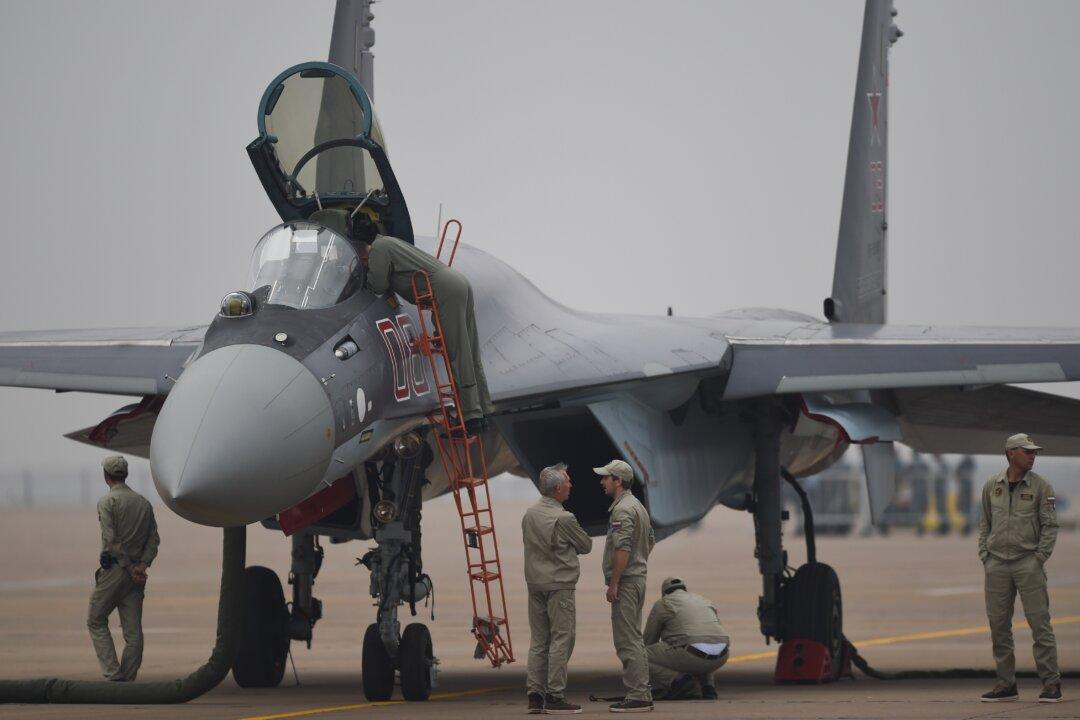This news analysis was originally dispatched as part of Epoch Times China email newsletters. Subscribe to the newsletters by filling your email in the “China D-brief” box under this article.
Imagine for a moment how the world would react if the United States spent $2 billion to purchase 16 Eurofighter Typhoon fighter jets. It would likely draw immediate speculation that U.S. development of the F-35 and F-22 jets had somehow failed.
This speculation should also hold true for a very real arms purchase that happened on Nov. 19, when the Chinese regime announced its $2 billion purchase of 24 Russian Su-35 fighter jets, at $83 million each.
On the surface, the purchase seems a bit odd. The Su-35 is a 4.5 generation fighter jet. The Chinese regime already has several 4.5 generation fighter jets it can build domestically (the JF-17, the JH-7, the J-10, and the J-11), and it’s currently developing two fifth-generation jets (the J-20 and the J-31).
The purchase should raise the question of why a country would purchase foreign jets, when it could allegedly build more powerful jets by itself.
The simple answer is that Chinese fighter jets have more problems than they'd like the world to think.
As a bit of background, the Chinese regime’s interests in the Su-35 aren’t new. Russia started negotiating in 2011 to sell the jets to China, and the negotiations were stalled for a while since the Chinese Communist Party (CCP) wanted the jets to be built in Chinese factories.
I reported in 2013 that history is repeating itself with the CCP’s interests in the Su-35. It mirrors what happened with the Chinese programs to develop the J-10 fighter jet.
The CCP began developing the J-10 in the 1980s, put out a prototype in the 1990s, and then in 1992 it purchased 50 Su-27s from Russia. The CCP’s purchase of the Russian jets was viewed as a sign that the J-10 programs were failing.
To this day, Russia remains the main supplier of China’s fighter jets and bombers, and many domestically-built Chinese planes still rely on Russian parts.
It wasn’t until 2006 that the CCP completed the J-10, and to this day, the jet relies on Russian parts—including Russian engines.
The CCP’s development of jet engines has been a blunder of its own. It announced in 2010 that it would start building its own jet engines—using the WS-10A, which was still a knock-off of a Russian engine. Just one year later, however, it went back to ordering Russian jet engines.
In this same light, the CCP’s purchase of the Su-35 jets could mean that it lacks faith in its own production of modern-generation fighter jets, including its J-20.
Behind the rhetoric, there are some serious problems in the CCP’s state-run jet companies. A manager at Shenyang Aircraft Corp. revealed some of these problems to Epoch Times in an interview last year, and exposed rampant corruption and faulty production methods.
The manager said four company executives were embezzling close to 100 million yuan ($16 million) a year. The manager claimed that key components in the J-8 fighter jet were built by temporary workers from eight factories—and noted these companies lacked training, certifications, and work authorization.
The manager also revealed there are hidden problems in the Chinese jets, which requires Shenyang Aircraft Corp. to have specialized repair teams on standby whenever the CCP’s air force operates its jets.
China Central Television (CCTV), one of the main mouthpieces of the CCP, aired some of these shortcomings in a recent video. It showed precision parts of the J-15 fighter jet being manually polished at Shenyang Aircraft Corp.
Chinese netizens were quick to poke fun at the broadcast, pointing out the components being hand polished are controlled at three micron precision, or about 0.0001 of an inch. One user wrote, “Nowadays advanced [computer numerical control] can completely achieve precision of two micron. The technician in the report would have to be a superman to be as precise as three micron.”
Also, while most news outlets were quick to trump up the Chinese purchase of the Su-35 jets as a kind of power shift that could challenge the U.S. fighter jets, they won’t do much to change the balance of power in the Asia-Pacific region.
The Su-35 is close to the capabilities of the Boeing F/A-18E/F Super Hornet. The United States has several 4.5 generation fighter jets, including retrofitted versions of the F-15, and the F-16.





